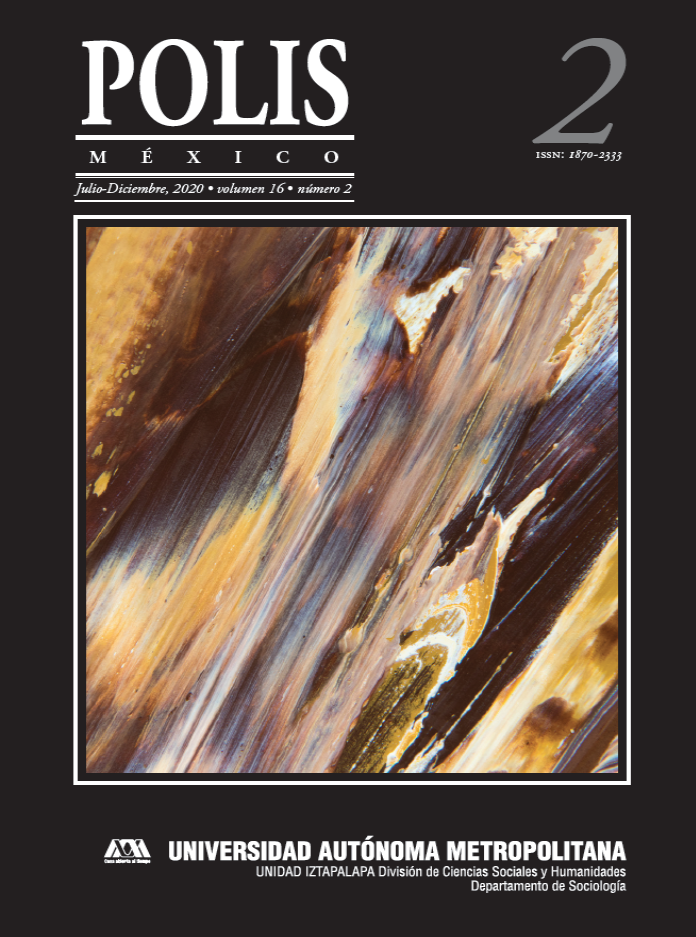Congressional Controls to the Executive Power in Mexico: 2018-2019
DOI:
https://doi.org/10.24275/uam/izt/dcsh/polis/2020v16n2/EscamillaKeywords:
Controles políticos, Poder Ejecutivo, Poder Legislativo.Abstract
The results of the 2018 federal election in Mexico reestablished the format of government with a majority and dominant party in Congress; on the other hand, thepartisan opposition decreased in size and was divided and weakened. This has fostered a dynamic of cooperation between the executive and the legislature, although it has been detrimental to the application of political controls and containment of the president’s actions. This work identifies the role played by the Mexican Congress in its functions of supervision and oversight towards the executive, regarding the approval of laws, creation of investigation commissions, appointments to appea rances and appointments, during the first year of theLXIV Legislature (2018 -2019).Downloads
References
Aragón, M. (1986a). Interpretación de la constitución y el carácter objetivado del control jurisdiccional. Revista Española de Derecho Constitucional. 6(17), 85-136.
Aragón, M. (1986b). El control parlamentario como control político. Revista de derecho político 23, 3-35.
Carbonell, M. y P. Salazar. (2006). División de poderes y régimen presidencial en México. México: UNAM.
Casar, M. A. (2013). Quince años de gobiernos sin mayoría en el Congreso mexicano. Política y Gobierno. 20(2), 219-263.
Colomer, J. (2001). Instituciones políticas. Barcelona: Ariel.
Espinoza Toledo, R. (2012). Sistemas parlamentario, presidencial y semi¬presidencial. México: IFE.
Huerta, C. (2010). Mecanismos constitucionales para el control del poder político. México: UNAM/IIJ.
Integralia (2019). Reporte Electoral Integralia, Elecciones Locales 2019. Resultados e implicaciones. CDMX, México: Integralia Consultores. Recuperado de: https://www.integralia.com.mx/SegundoReporteElectoralIntegraliaLocales2019.pdf
Leonardo, M., A. Pérez-Liñán y M García. (2014). El control presidencial de la agenda legislativa en América Latina. Revista de Ciencia Política. 34(3), 511-536.
Lijphart, A. (2000). Modelos de Democracia. Formas de gobierno y resultados en treinta y seis países. Barcelona: Ariel.
Loewenstein, K. (1976), Teoría de la constitución, Barcelona: Ariel.
Mora-Donatto, C. (2006). Cambio político y legitimidad funcional. El Congreso mexicano en su encrucijada. México: Miguel ángel Porrúa.
Murayama, C. (2018). La captura del Congreso. Nexos. 25 (499), 28-33. Recuperado de: https://www.nexos.com.mx/?cat=3416
Nacif, B. (2010). El fin de la presidencia dominante: la confección de las leyes en un gobierno dividido. En J. L. Méndez. (Coord.), Los grandes problemas de México. XIII, Políticas Públicas (pp.45-83). México: El Colegio de México.
Negretto, G. (2015). La política del cambio constitucional en América Latina. México: FCE.
Neustadt, R. (1990). Presidential power and the modern president: The politics of leadership from Roosvelt to Reagan. New York: Free Press.
Sartori, G. (1996). Ingeniería Constitucional Comparada. México: FCE.
Secretaria de Gobernación (2019). Sistema de Información Legislativa. CDMX, México: Dirección General de Información Legislativa. Recuperado de: http://sil.gobernacion.gob.mx/Numeralia/Iniciativas/numiniciativas.php
Valadés, D. (2009). Problemas y perspectivas del sistema presidencial mexicano. En A. Ellis, J. O. Henríquez y D. Zovatto (Coords.), Cómo hacer que funcione el sistema presidencial (pp. 429-475) México: UNAM/IIJ.
Valencia, L. (2013). Equilibrio de poderes, cooperación y la conformación de gobiernos de coalición en México. Revista Legislativa de Estudios Sociales y de Opinión Pública. 6(11). México: Cámara de Diputados/CESOP, 7-44.



